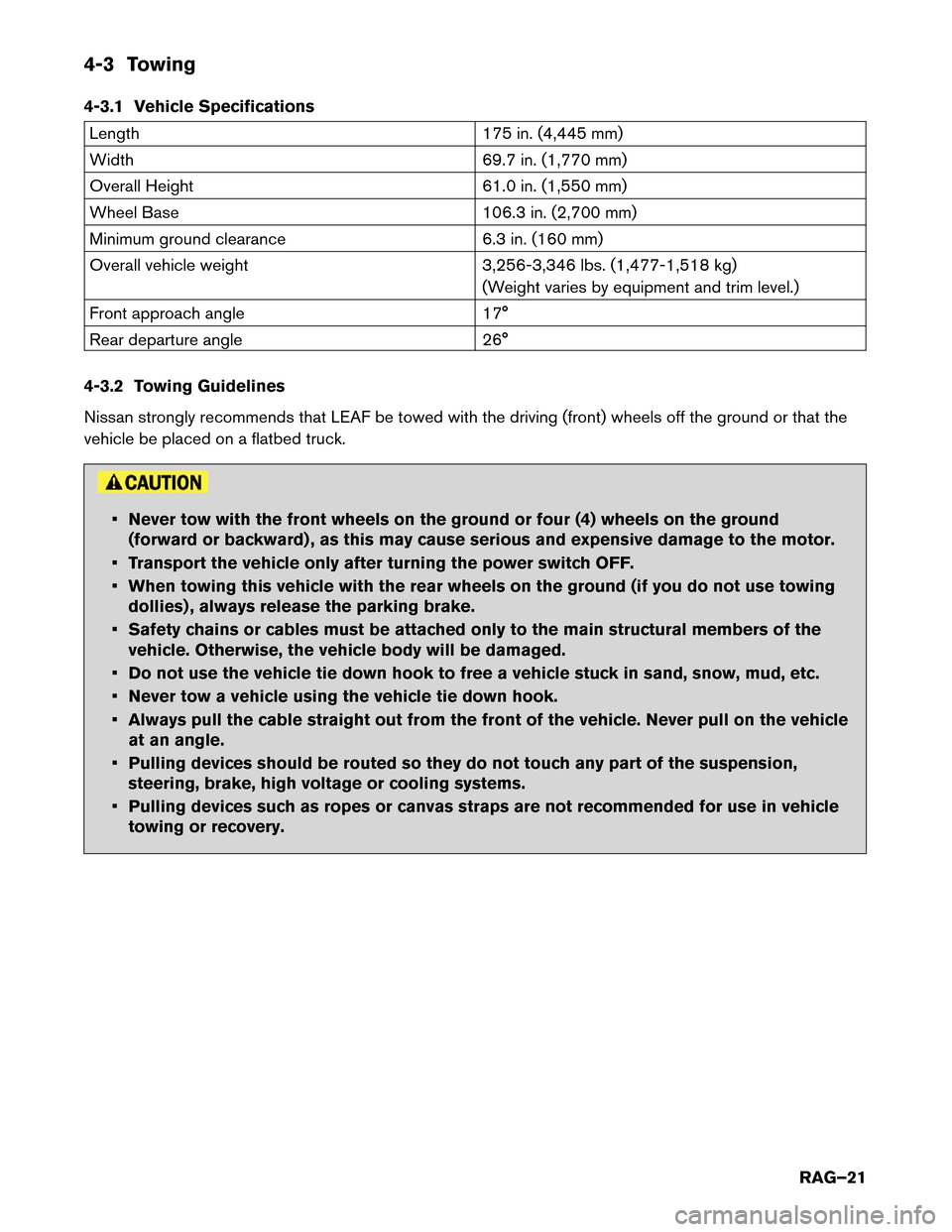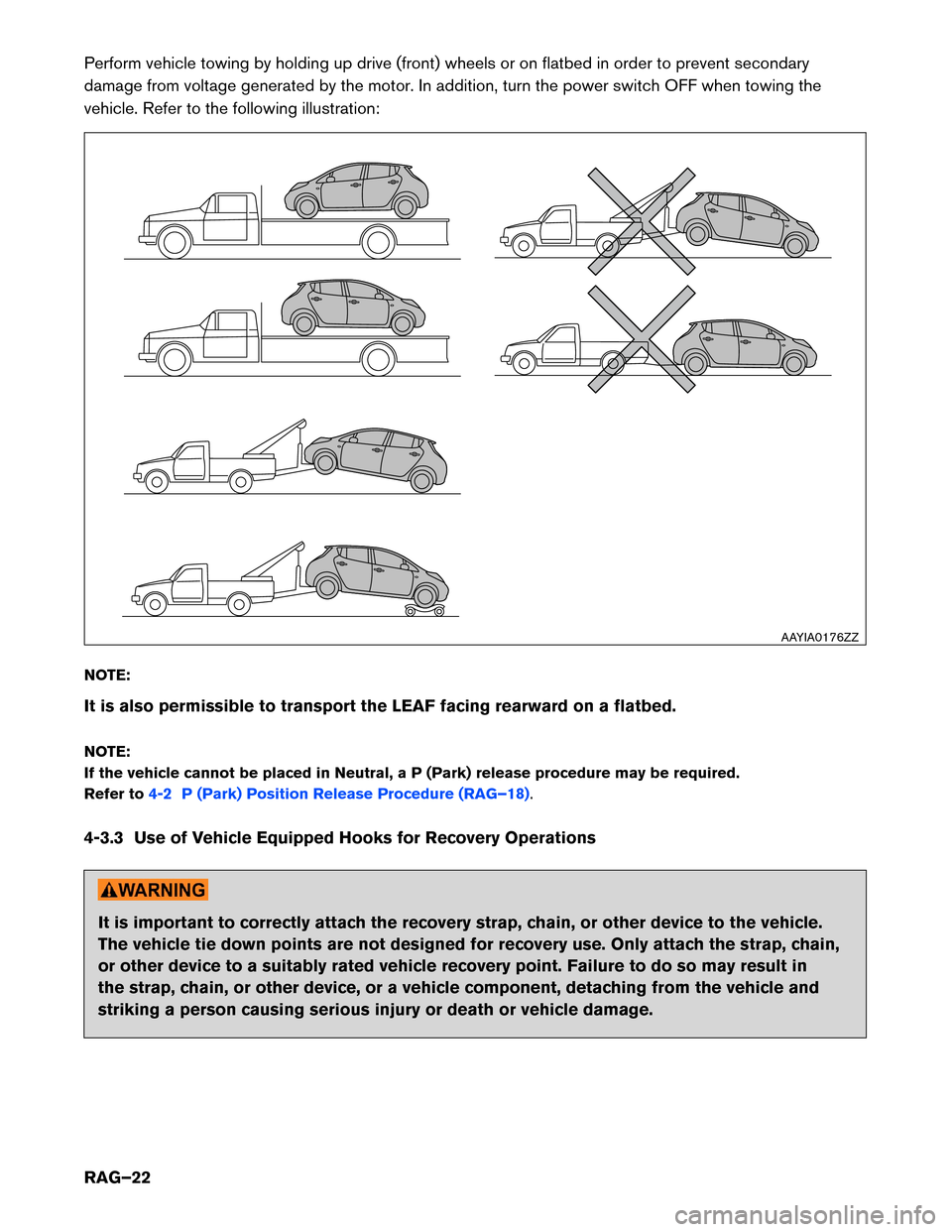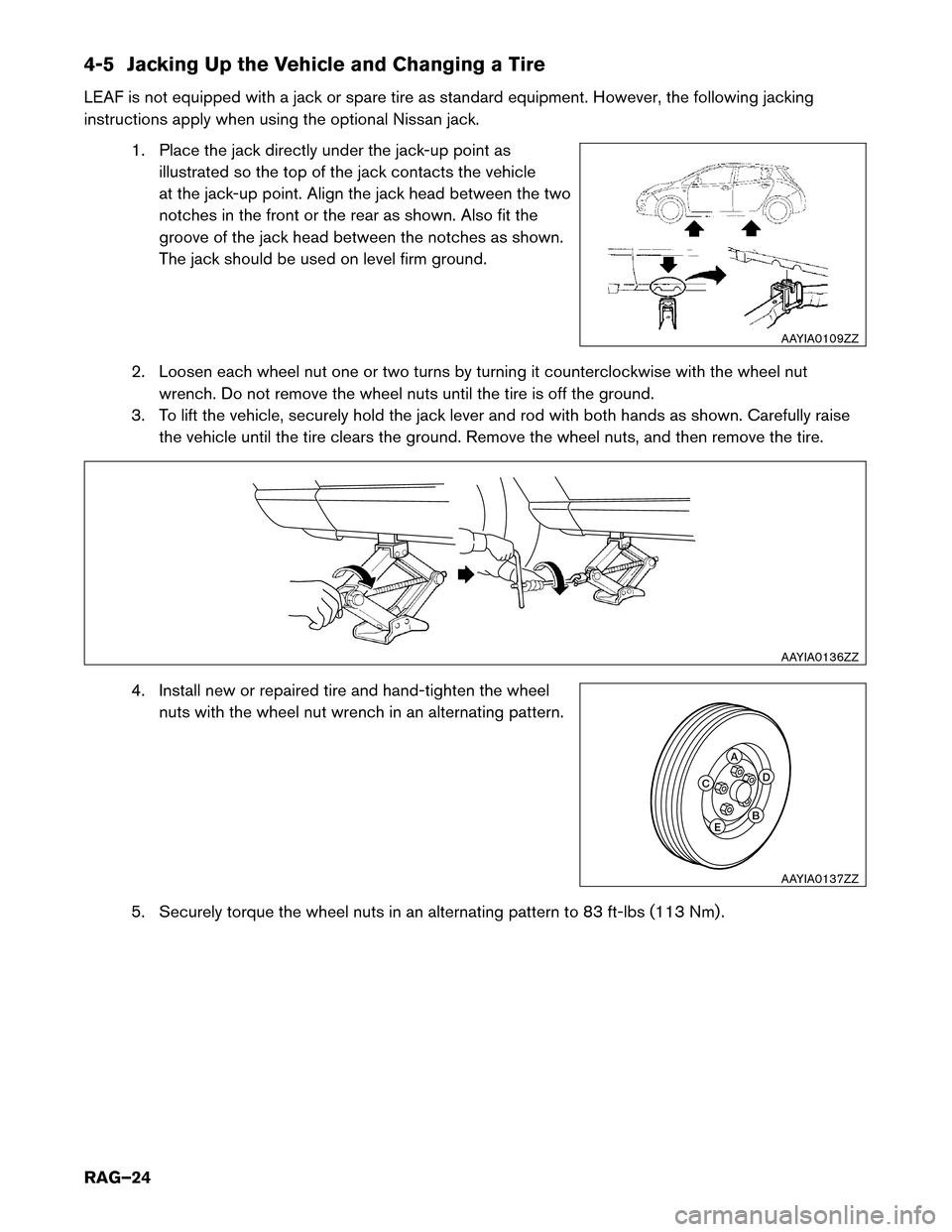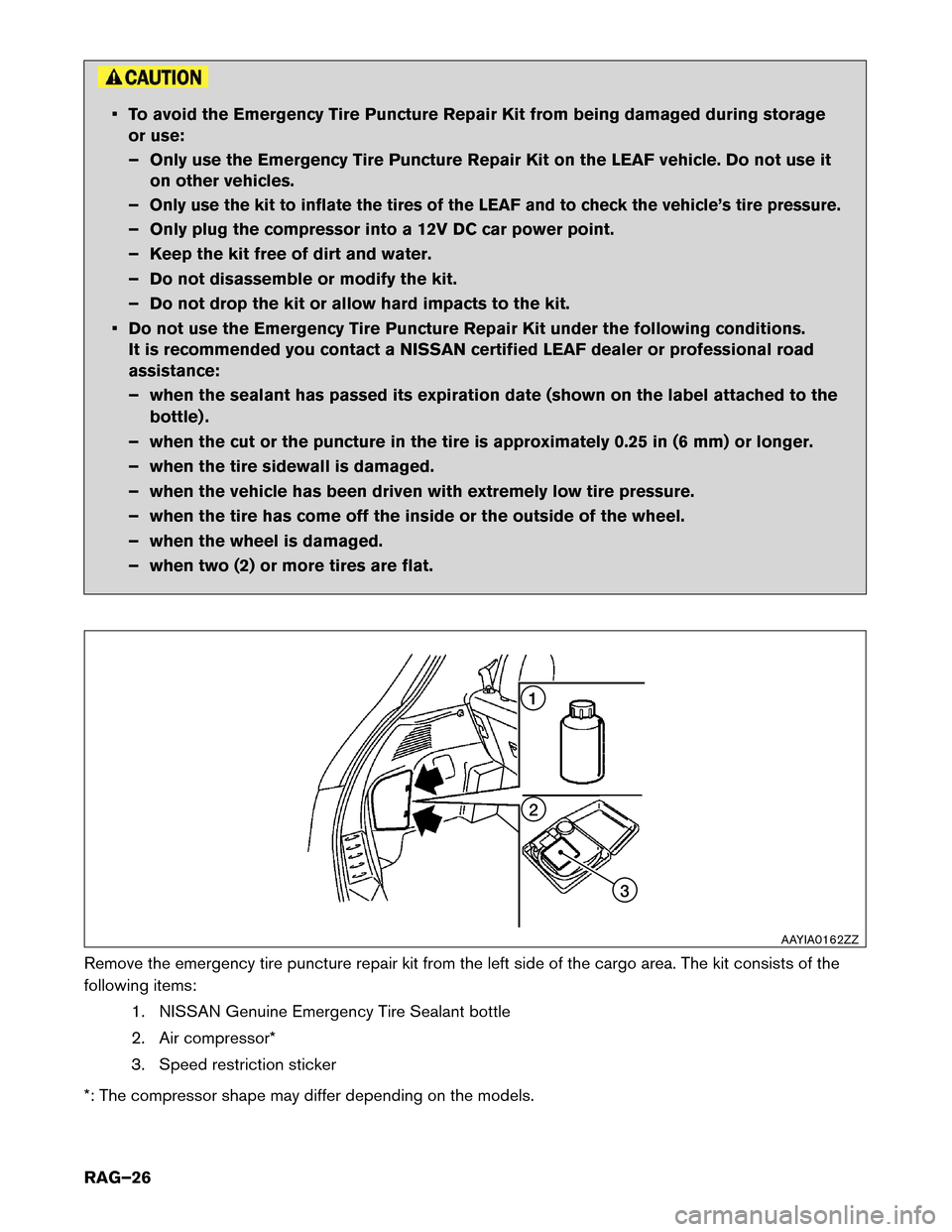Page 13 of 36
3-2 Vehicle Immobilization and Stabilization
If
possible, immobilize the vehicle by turning the 12V system OFF and stabilize it with a wheel chock(s) .
Stabilize the vehicle with wooden blocks or by removing air from the tires. • Do not stabilize the vehicle with wooden blocks under the high voltage battery.
•
To avoid electrical shock, do not put wooden blocks or wheel chock(s) under the high
voltage components and harnesses as shown following. =
=
�� ��
3 N - 3
3 N - 4
3 N - 1 3 N - 2
��� ��� ���DANGER High voltage battery
Do Not Lift Zone
High voltage battery
AAYIA0148GBRAG–13
Page 20 of 36
Cabin Fuse Box Location
NO
TE:
Insert a screwdriver wrapped with a protective cloth (A) into the slit (1) . Pull to remove the fuse
box cover (2) . Remove the fuse with the fuse puller (3) .
7. Release the parking brake.
8. Turn the power switch OFF.
9. Release brake pedal. To avoid possible personal injury or vehicle damage, use wheel chocks or take appropriate
steps
to prevent the vehicle from rolling freely.
Be sure to firmly position wheel chocks when P (Park) position is manually released.
4-2.1 Reset Procedure 1. Install the 2 fuses removed previously.
2. Turn the power switch ON and wait 5 seconds without pressing the brake pedal. Ensure selectorlever is in the N (neutral) position.
3. If 12-volt battery is low voltage, please charge with battery charger.
4. Turn the power switch OFF and wait 5 seconds. UP
METER 1
10A
11 3
2
A
AAYIA0151ZZ
RAG–20
Page 21 of 36

4-3 Towing
4-3.1
Vehicle Specifications Length
175
in. (4,445 mm)
Width 69.7 in. (1,770 mm)
Overall Height 61.0 in. (1,550 mm)
Wheel Base 106.3 in. (2,700 mm)
Minimum ground clearance 6.3 in. (160 mm)
Overall vehicle weight 3,256-3,346 lbs. (1,477-1,518 kg)
(Weight varies by equipment and trim level.)
Front approach angle 17°
Rear departure angle 26°
4-3.2 Towing Guidelines
Nissan strongly recommends that LEAF be towed with the driving (front) wheels off the ground or that the
vehicle be placed on a flatbed truck. • Never tow with the front wheels on the ground or four (4) wheels on the ground
(forward
or backward) , as this may cause serious and expensive damage to the motor.
• Transport the vehicle only after turning the power switch OFF.
• When towing this vehicle with the rear wheels on the ground (if you do not use towing dollies) , always release the parking brake.
• Safety chains or cables must be attached only to the main structural members of the vehicle. Otherwise, the vehicle body will be damaged.
• Do not use the vehicle tie down hook to free a vehicle stuck in sand, snow, mud, etc.
• Never tow a vehicle using the vehicle tie down hook.
• Always pull the cable straight out from the front of the vehicle. Never pull on the vehicle at an angle.
• Pulling devices should be routed so they do not touch any part of the suspension, steering, brake, high voltage or cooling systems.
• Pulling devices such as ropes or canvas straps are not recommended for use in vehicle towing or recovery.
RAG–21
Page 22 of 36

Perform vehicle towing by holding up drive (front) wheels or on flatbed in order to prevent secondary
damage
from voltage generated by the motor. In addition, turn the power switch OFF when towing the
vehicle. Refer to the following illustration:
NOTE:
It is also permissible to transport the LEAF facing rearward on a flatbed.
NOTE:
If the vehicle cannot be placed in Neutral, a P (Park) release procedure may be required.
Refer to 4-2 P (Park) Position Release Procedure (RAG–18).
4-3.3
Use of Vehicle Equipped Hooks for Recovery Operations It is important to correctly attach the recovery strap, chain, or other device to the vehicle.
The
vehicle tie down points are not designed for recovery use. Only attach the strap, chain,
or other device to a suitably rated vehicle recovery point. Failure to do so may result in
the strap, chain, or other device, or a vehicle component, detaching from the vehicle and
striking a person causing serious injury or death or vehicle damage. AAYIA0176ZZ
RAG–22
Page 24 of 36

4-5 Jacking Up the Vehicle and Changing a Tire
LEAF
is not equipped with a jack or spare tire as standard equipment. However, the following jacking
instructions apply when using the optional Nissan jack.
1. Place the jack directly under the jack-up point asillustrated so the top of the jack contacts the vehicle
at the jack-up point. Align the jack head between the two
notches in the front or the rear as shown. Also fit the
groove of the jack head between the notches as shown.
The jack should be used on level firm ground.
2. Loosen each wheel nut one or two turns by turning it counterclockwise with the wheel nut wrench. Do not remove the wheel nuts until the tire is off the ground.
3. To lift the vehicle, securely hold the jack lever and rod with both hands as shown. Carefully raise the vehicle until the tire clears the ground. Remove the wheel nuts, and then remove the tire.
4. Install new or repaired tire and hand-tighten the wheel nuts with the wheel nut wrench in an alternating pattern.
5. Securely torque the wheel nuts in an alternating pattern to 83 ft-lbs (113 Nm) . AAYIA0109ZZ
AAYIA0136ZZ
B
EC DA
AAYIA0137ZZ
RAG–24
Page 26 of 36

• To avoid the Emergency Tire Puncture Repair Kit from being damaged during storage
or use:
– Only use the Emergency Tire Puncture Repair Kit on the LEAF vehicle. Do not use it on other vehicles.
–
Only use the kit to inflate the tires of the LEAF and to check the vehicle’s tire pressure.
– Only plug the compressor into a 12V DC car power point.
– Keep the kit free of dirt and water.
– Do not disassemble or modify the kit.
– Do not drop the kit or allow hard impacts to the kit.
• Do not use the Emergency Tire Puncture Repair Kit under the following conditions. It is recommended you contact a NISSAN certified LEAF dealer or professional road
assistance:
– when the sealant has passed its expiration date (shown on the label attached to the
bottle) .
– when the cut or the puncture in the tire is approximately 0.25 in (6 mm) or longer.
– when the tire sidewall is damaged.
– when the vehicle has been driven with extremely low tire pressure.
– when the tire has come off the inside or the outside of the wheel.
– when the wheel is damaged.
– when two (2) or more tires are flat.
Remove the emergency tire puncture repair kit from the left side of the cargo area. The kit consists of the
following items: 1. NISSAN Genuine Emergency Tire Sealant bottle
2. Air compressor*
3. Speed restriction sticker
*: The compressor shape may differ depending on the models. 321
AAYIA0162ZZ
RAG–26
Page 27 of 36
4-6.1 Before Using Emergency Tire Puncture Repair Kit
• If any foreign object (for example, a screw or nail) is embedded in the tire, do not remove it.
• Check the expiration date of the sealant (shown on the label attached to the bottle) . Never use a sealant if the expiration date has passed.
4-6.2 Repairing the Tire 1. Take out the speed restriction sticker from the aircompressor, then put it in a location where the driver can
see it while driving. Do not obstruct the view of gauges or
warning
lights with the sticker. Do not put the
sticker on the steering wheel pad.
2. Take the hose (1) and power plug (2) out of the aircompressor. Remove the cap of the bottle holder from
the air compressor.
3. Remove the cap from the tire sealant bottle and screw the bottle clockwise onto the bottle holder. Leave the
bottle seal intact. Screwing the bottle onto the bottle
holder will pierce the seal of the bottle. AAYIA0131ZZ
2
1
AAYIA0132ZZ AAYIA0133ZZ
RAG–27